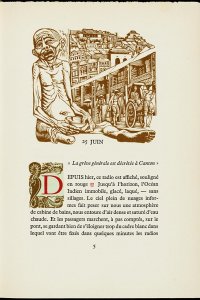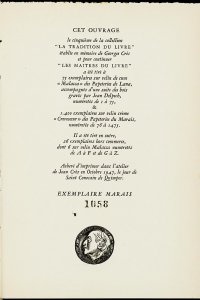Les conquérants
Year: 1947
Author: André Malraux (1901 - 1976)
Artist: Jean Delpech (1916 - 1988)
Publisher: Georges Crès & Cie
Release of writing talent
The petition included the autographs of André Gide, François Mauriac, Max Jacob, Louis Aragon, André Breton and publisher Gaston Gallimard, among others. As the main reason for setting Malraux free, his friends submitted that it was unacceptable to detain such a great writing talent as Malraux. This was a curious argument to make at that time, as the talented adventurer had had only written a single book, Lunes en papier, and a few articles. They would however be proved right, for Malraux published novels not long after his Cambodian adventure that would forever establish his reputation as a brilliant author: Les conquérants (1928), La voie royale (1930) (about a 'young archaeologist'searching for Khmer art in the Cambodian jungle), and especially La condition humaine, for which he was awarded the Prix Goncourt in 1933. All these books are set in Asia, the continent that continued to fascinate Malraux in spite of his failed Cambodian adventure. Perhaps as a result of his humiliating prison experiences in Phnom-Penh and his direct contact with a suppressed population, he chose the path of revolution.
Les conquérants begins in June 1925. The novel deals with revolts in Canton and Hong Kong, and the actions of the young Pierre Garine from Switzerland, who has sided with the Chinese revolutionaries. The book had such an impact due the to way in which Malraux portrayed his protagonist: not as a nationalist, or as someone driven by religious feelings or by anything else, but as someone who claimed to be completely apolitical. His only motivation was perhaps a vague fear of mortality. Although his alter ego Garine finds life completely absurd and pointless, he does fight alongside the suppressed Chinese. His antagonists are Borodine, the Russian party stooge who wants to force the communist Soviet system on the Chinese, the terrorist Hong and the pacifist Tcheng Dai, a kind of Ghandi-figure who commits suicide as the ultimate form of protest.
Banned book
The lack of political moralism and revolutionary optimism in Les conquérants was not universally appreciated.
The book was banned in communist Russia as well as in fascist Italy. In a reply to Trotsky, who found that Garine could have prevented many blunders in Canton if he had followed the right Marxist line, Malraux responded that the book was no romanticised chronicle of the Chinese revolution, but an indictment of human nature. In his most famous book, La condition humaine, published in the Netherlands under the telling title Het menselijk tekort (The human failing), Malraux would further elaborate his theme of action versus moralism/nihilism.
The 1947 edition of Les conquérants includes several woodengravings and vignettes by Jean Delpech (1916-1988), an artist who was familiar with Asia, like Malraux. Delpech was born in Hanoi, and live in France since 1935. He illustrated books, but also worked as an advertising artist, produced comic books and murals, and designed postage stamps. He employed his striking, decorative and sharp drawing style for this book as well, which was published by Jean Crès and was included in the series 'La tradition du livre', started to commemorate the publisher’s founder Geoges Crès. The old Crès made his name with illustrated books before World War II. His work contributed to the renewed interest in woodengravings. Delpech's illustrations therefore are part of a longer tradition.
Bibliographical description
Description: Les conquérants / par André Malraux ; front. et bandeaux grav. sur bois par Jean Delpech. - Paris : Georges Crès & Cie, 1947. - [267] p. : ill. ; 20 cm
1st edition: 1928
Printer: Jean Crès (Paris)
Edition: 1501 copies
This copy: Number 1058 of 1400 on vélin crème Crèvecoeur du Marais
Bookbinder: Verschoor (Voorburg)
Shelfmark: KW Koopm C 2272
References
- Rémi Kauffer, André Malraux (1901-1976): Le roman d'un flambeur. Paris, Hachette Littératures, 2001
- François de Saint-Cheron, André Malraux. Paris, Ministère des Affaires étrangères, Direction générale des Relations culturelles, scientifiques et techniques, Sous-direction de la Politique du livre et des bibliothèques, 1996
- Olivier Todd, André Malraux: Une vie. Paris, Gallimard, 2001








![Pagina [33]met zeefdruk door Jean Dubuffet](/sites/default/files/styles/gerelateerd_item_mob/public/images/cerceaux-sorcellent-p33.jpg?h=4383cfe0&itok=R0R4eBSx)
![Le voyage d'Urien, pagina [1] met litho door Maurice Denis](/sites/default/files/styles/gerelateerd_item_mob/public/images/voyage-durien_p1.jpg?h=4228373b&itok=BNJwDz_L)